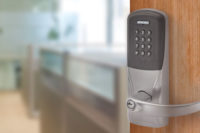
|
How would you define wireless access control? Is it wireless at the reader, wireless at the panel, or both? Systems integrators use different types of wireless technology to get a perfect fit.
“It is a semantic problem,” says Jesse Abbott, president, Advance Technology Inc., Scarborough, Maine. “The word is vague and can mean a number of different things. For us, primarily in the past wireless has been used for remote gates. Those systems use a wireless transmitter and receiver, but the actual card reader and panel sit out at the gate and we send signals back by line-of-sight to the main building. That has probably been the most common scenario in the past.
“But today we are using more wireless access in laboratories and clinics where we will put a module in the ceiling that wires back to a panel and allows us to install two or three different locks that work with that. These are battery-operated locks that have all the components built into them, such as door position switches and request-to-exit.”
The main advantages of these types of locks, he says, are the ability to cut installation time by 80 percent by not pulling wires. “The average cost of an access control door is $2,500 to $3,000 per door. This can be done for $1,200 to $1,400 per door and allows us to do six doors in a hallway in a day.”
Dave Whittington, compliance officer and special projects manager, Blue Ridge Security Systems, Anderson, S.C., primarily uses wireless technology to allow the panel to communicate wirelessly with the network. The wireless market in general is heating up due to customer demand and expectation, he says.
“People ask us about wireless all the time,” Whittington says. “They have in their mind that if you can make this wireless it will be cheaper for them. Sometimes it is and sometimes it isn’t — especially if you use good wireless. Good wireless is not cheap.”
Abbott agrees, saying, “Wireless for access control is becoming more mainstream every day. It is a bit of a niche, but it is similar to kids today demanding wireless handheld devices. Everyone wants every device to work that way.”
WIRELESS IN USE
However the “wireless” portion is accomplished, most integrators and dealers would agree that, at least for now, it is almost always the solution to a problem that could not be accomplished using wires due to either construction issues or economics. Wireless access applications span across all vertical markets and vary widely in use and the reason behind the installation.
Several integrators recently spoke with SDM about some of the installations they have performed in which wireless access control technology was the ideal fit.
Medical Cath Lab

|
Advance Technology faced a challenge when the company was asked to install access control in a medical facility, Abbott says. “The cath laboratory was a medical procedure room with about $1 million worth of equipment they don’t want people messing with, in addition to about $100,000 worth of consumables like stents just laid out on the counter. This is the room where they do angioplasties and other heart procedures.”
The medical facility had previously used a lock-and-key system, but it wasn’t working well for them. “The problem was that these rooms were staffed about 40 hours per week but potentially needed to be accessed 24/7. With the key approach they were using they had no idea who was there, when. They needed an audit trail.”
Unfortunately, when Abbott did a site walk he came across a roadblock: lead-lined walls they couldn’t run cables through.
The wireless system that worked for this application was a Schlage system that uses PIMs (panel interface modules) to get to the closest available wired point to connect with the system. The actual door locks are wireless, battery-operated, all-inclusive locks.
“Typically there are a series of about six doors and the PIM device is inside of the door. The tough part here was that you should be able to set up six to eight doors on one PIM and they make them in various configurations, but because of the nature of these rooms we had to use multiple PIMs across the hall from each other.
“This is what would work. It would not have been an option to go wired. It was this or lock-and-key, which wasn’t cutting it for them.”
Bottling Facility

|
“Our key account is Coca Cola Consolidated,” Whittington says. “Because they are a food manufacturer they obviously have to have good security.
“All bottling facilities have a perimeter that is well protected with gates, but in this case the right solution was to use wireless rather than run wire that would require us to dig up the asphalt. There were also waste treatment facilities there that were a distance away. It was more cost-effective to do wireless. We also used wireless where the guard stations are.”
The manufacturing process uses ammonia, Whittington reveals, which needed to be in a controlled area. “Because of where that was located it would be difficult to get wire to it.”
In all of these areas, they had power to the door or gate that needed securing, but no wires run back to the panel, so wireless panels were the perfect solution. “As in most of our wireless applications the read head is connected to the controller panel by a wire. But the communication from the controller panel to the rest of the system is done wirelessly.
“We are old school. If we can put a wire on it, we do, but sometimes it is just not feasible. There are times it is more cost-effective to do it wirelessly, but it has to be effective and good, especially when you are talking food defense.”
Historic School Building

|
Matthew Ladd, president of Exton, Pa.-based The Protection Bureau, SDM’s 2010 Dealer of the Year, had one particular client — a private school with about six buildings that made up its campus. “They wanted access control — primarily single or two doors per building — but the campus was an old stone farmhouse with buildings that had been added over the years. The buildings were old and difficult to run wires in. There were very few basements or attics or drop ceilings. There was no way to run wires to the doors so the decision was made that wireless would be the most cost-efficient option.
“We actually ended up doing a 100 percent wireless access control system for them. We went to each of the entrance doors they wanted to control and installed a wireless card reader and lock. That then communicated back through a receiver to the access control system. Through the network they were able to communicate to each building to lock and unlock doors all with no cabling between buildings at all and very little inside the building.”
The installation itself went smoothly, but the school and integrator were puzzled when the battery life to the locks was lasting only two days.
“We couldn’t figure it out at first, but it turned out that the customer for years had been used to unlocking all the doors every morning by dogging down the panic bar with an Allen wrench. With the new system this created a request-to-exit communication every second. Once we told them not to do that and to allow the access system to do its job everything was fine.”
BaptistChurch

|
SFI Electronics, Charlotte, N.C., found wireless to be a good solution for a Baptist Church it was working on. “We find it is the best fit when you have a large distance to cover between either buildings or gates where trenching and running pipe is cost-prohibitive,” says Jason Elkins, branch manager and system consultant for the Columbia area office.
“This job at the church had a lot of open areas between buildings. They had a central building that was hardwired but had expanded to two extra buildings that they decided to secure later. They were looking for a way to secure the buildings while controlling costs.
“As an integrator we went and assessed the situation and presented them with what we thought would work, which in this case was a wireless system. We let them know we could trench and hardwire but it would quadruple their cost. We led them to the logical path of the secure wireless bridge from one panel to another.”
The church even got an extra benefit: a wireless network, which they didn’t have before.
Parking Lots
Entries and parking lots are often good cases for wireless technology, because it overcomes the obstacle of digging up existing concrete. This was the case that Barry Roseman, salesman at Alscan Inc., Birmingham, Ala, found at a few of his installations.
One was a gas plant. “What they did for years is had a gate and rolled it shut at the end of the night. But now they were open 24/7 and needed some type of access at the gate. They had power to the gate and a way to open and close it, but no access control. Because these big, heavy trucks came through there was really no way to saw the concrete up because it would stress it and cause cracks. This particular site had 18-inch thick slabs, so in order to transmit data back and forth wireless was the only solution that would work. It solved a problem that would have been very expensive any other way.”
In the process of doing that installation, Roseman learned a valuable lesson about signals, however. “We mounted the system 22 feet off the ground. But they have big tanker trucks that carry compressed gas or air in them. Due to the shape of the signal we used, when the truck would get to a certain point, part of that signal would bounce off the tank of the tractor-trailer and cause shadows and degradation of the signal. We had to raise them, re-aim them and focus the wave as tight as possible, and then it worked fine.”
Another parking lot application Alscan tackled was a large church that had a brand new 3,000-car parking lot situated between two major streets. “They were concerned about security and wanted to put access on the front gates to let people who were supposed to be there after hours. They wanted the gates closed at night, but to give people access cards as needed. The only solution for that was to use a wireless link.”
Oil Company
Some wireless solutions don’t involve stationary readers at all. This is the case with one application Vision Security Technologies, Birmingham, Ala., ran across.
An oil company needed to comply with government TWIC card regulations and be able to verify the credentials as well as the credential holders by both card and biometric. Normally this is done using the regular access control system, but in certain cases, a different solution is needed.
“Due to the nature of their business and the amount of flammables they have, every person, including truck drivers, are required to have TSA credentials,” explains Alex Volubuev, engineer. “The thing is, the majority of full-time employees go through the regular access control system. But when a person is not in the system but is a TWIC card holder who hasn’t been enrolled, the company can take this hand-held device and walk to the truck to verify that the card is valid. It is not used for every person entering the site, but for new people to make sure they have a valid card.
“It is a very sophisticated device. It can read the government-issued card as well as fingerprints. A Wi Fi connection puts it on the network and it talks to servers so the card can be verified real-time.”
WHAT THE FUTURE HOLDS
Integrators may not agree on the extent to which wireless access control will be used in the future but they all agree it is here to stay. There are some drawbacks and limitations with it, they say, but an equal number of benefits if not more.
“It is in its early adoption stage,” Abbott says. “Wireless probably represents less than one percent of doors out there and it should represent 10 to 20 percent over the next five years. Not every application is necessarily appropriate for it. We did one in a hospital where there were seven other things on that floor in that range.”
Whittington agrees. “Hardwired is still the most reliable out there. Wireless is more subjected to electromagnetic forces such as RF signals from airplanes overhead. You would be amazed at the electronic pollution that is around all the time. When you use wireless you have to use good gear that doesn’t get confused by that.”
Particularly in outdoor applications, line-of-sight can be obstructed by trailers, buildings or even weather.
“Things can change,” Whittington describes. “It can work today and then somebody puts a big transformer in between and alters the signal. Wireless is subject to environmental conditions as much, if not more than any other system. It can be tricky.”
Batteries also could be an issue. “I have been in this business for 25 years, Whittington adds. “I have seen people come up with good wireless products, but we are talking reliability issues and unknowns. In lots of cases there is the dreaded battery. Manufacturers say it will say it will last this long or that long. But will it be supervised? Will it ever be all wireless? It seems to me there are limits on this, but who knows? I would have never thought years ago I would operate my home computer on a wireless card either.”
Ladd envisions a very bright future for wireless access control. “We see a real value. What I think you will find is that perimeters on new construction will stay wired. But internally, when you take into account that the average integrator sees maybe 5 percent of doors, there is that other 95 percent that wireless may be a perfect application for. That has not been part of the sales approach in the past, but now we have that opportunity.
“Wireless will continue to grow. Networks are far more readily available or we can set up our own to create the pathway. Manufacturers are developing more and more products at much more competitive price ranges so our clients will be able to do so many more than just the typical 5 percent of doors,” Ladd thinks.





